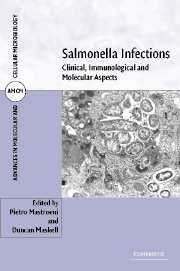Book contents
- Frontmatter
- Contents
- List of contributors
- Preface
- 1 Epidemiological and clinical aspects of human typhoid fever
- 2 Antibiotic resistance in Salmonella infections
- 3 Host-specificity of Salmonella infections in animal species
- 4 Public health aspects of Salmonella enterica in food production
- 5 The Salmonella genome: a global view
- 6 Pathogenicity islands and virulence of Salmonella enterica
- 7 In vivo identification, expression and function of Salmonella virulence genes
- 8 Mechanisms of immunity to Salmonella infections
- 9 Interactions of S. enterica with phagocytic cells
- 10 Interactions between Salmonella and dendritic cells: what happens along the way?
- 11 Immunity to Salmonella in domestic (food animal) species
- 12 Newer vaccines against typhoid fever and gastrointestinal salmonelloses
- 13 S. enterica-based antigen delivery systems
- Index
- Plate section
- References
1 - Epidemiological and clinical aspects of human typhoid fever
Published online by Cambridge University Press: 04 December 2009
- Frontmatter
- Contents
- List of contributors
- Preface
- 1 Epidemiological and clinical aspects of human typhoid fever
- 2 Antibiotic resistance in Salmonella infections
- 3 Host-specificity of Salmonella infections in animal species
- 4 Public health aspects of Salmonella enterica in food production
- 5 The Salmonella genome: a global view
- 6 Pathogenicity islands and virulence of Salmonella enterica
- 7 In vivo identification, expression and function of Salmonella virulence genes
- 8 Mechanisms of immunity to Salmonella infections
- 9 Interactions of S. enterica with phagocytic cells
- 10 Interactions between Salmonella and dendritic cells: what happens along the way?
- 11 Immunity to Salmonella in domestic (food animal) species
- 12 Newer vaccines against typhoid fever and gastrointestinal salmonelloses
- 13 S. enterica-based antigen delivery systems
- Index
- Plate section
- References
Summary
INTRODUCTION
Typhoid fever is an acute systemic infection caused by the bacterium Salmonella enterica serovar Typhi. Salmonella enterica serovars Paratyphi A, B, and C cause the clinically similar condition, paratyphoid fever. Typhoid and paratyphoid fevers are collectively referred to as enteric fevers. In most endemic areas, approximately 90% of enteric fever is typhoid. Typhoid is transmitted by the fecal-oral route via contaminated food and water and is therefore common where sanitary conditions are inadequate and access to clean water is limited. Although typhoid fever was common in the United States and Europe in the 19th century, it is now encountered mostly throughout the developing world. In the last fifteen years, the emergence of resistance to the antibiotics used for treatment has led to large epidemics, and complicated the management of this serious disease.
Before the 19th century, typhoid fever was commonly confused with other prolonged febrile syndromes, particularly typhus fever. Following the observations of Huxham, Louis, Bretonneau, Gerhard and William Jenner, by the middle of the 19th century the two conditions were clearly differentiated (Richens, 1996). In 1873, William Budd described the contagious nature of the disease and incriminated fecally contaminated water sources in transmission. The causative organism was visualized in tissue sections from Peyer's patches and spleens of infected patients by Eberth in 1880 and was grown in pure culture by Gaffky in 1884. The organism has been variously known as Bacillus typhosus, Erbethella typhosa, Salmonella typhosa and Salmonella typhi.
- Type
- Chapter
- Information
- Salmonella InfectionsClinical, Immunological and Molecular Aspects, pp. 1 - 24Publisher: Cambridge University PressPrint publication year: 2006
References
- 9
- Cited by



